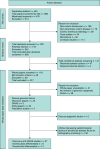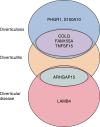Genetic, epigenetic and environmental factors in diverticular disease: systematic review
- PMID: 38831715
- PMCID: PMC11148476
- DOI: 10.1093/bjsopen/zrae032
Genetic, epigenetic and environmental factors in diverticular disease: systematic review
Abstract
Background: Diverticulosis is a normal anatomical variant of the colon present in more than 70% of the westernized population over the age of 80. Approximately 3% will develop diverticulitis in their lifetime. Many patients present emergently, suffer high morbidity rates and require substantial healthcare resources. Diverticulosis is the most common finding at colonoscopy and has the potential for causing a significant morbidity rate and burden on healthcare. There is a need to better understand the aetiology and pathogenesis of diverticular disease. Research suggests a genetic susceptibility of 40-50% in the formation of diverticular disease. The aim of this review is to present the hypothesized functional effects of the identified gene loci and environmental factors.
Methods: A systematic literature review was performed using PubMed, MEDLINE and Embase. Medical subject headings terms used were: 'diverticular disease, diverticulosis, diverticulitis, genomics, genetics and epigenetics'. A review of grey literature identified environmental factors.
Results: Of 995 articles identified, 59 articles met the inclusion criteria. Age, obesity and smoking are strongly associated environmental risk factors. Intrinsic factors of the colonic wall are associated with the presence of diverticula. Genetic pathways of interest and environmental risk factors were identified. The COLQ, FAM155A, PHGR1, ARHGAP15, S100A10, and TNFSF15 genes are the strongest candidates for further research.
Conclusion: There is increasing evidence to support the role of genomics in the spectrum of diverticular disease. Genomic, epigenetic and omic research with demographic context will help improve the understanding and management of this complex disease.
© The Author(s) 2024. Published by Oxford University Press on behalf of BJS Foundation Ltd.
Figures
References
-
- Tursi A, Brandimarte G, Di Mario F, Elisei W, Picchio M, Allegretta L et al. Prognostic performance of the ‘DICA’ endoscopic classification and the ‘CODA’ score in predicting clinical outcomes of diverticular disease: an international, multicentre, prospective cohort study. Gut 2022;71:1350–1358 - PubMed
-
- Ebersole J, Medvecz AJ, Connolly C, Sborov K, Matevish L, Wile G et al. Comparison of American Association for the Surgery of Trauma grading scale with modified Hinchey classification in acute colonic diverticulitis: a pilot study. J Trauma Acute Care Surg 2020;88:770–775 - PubMed
-
- Tănase I, Păun S, Stoica B, Negoi I, Gaspar B, Beuran M. Epidemiology of diverticular disease—systematic review of the literature. Chirurgia (Bucur) 2015;110:9–14 - PubMed
Publication types
MeSH terms
LinkOut - more resources
Full Text Sources
Miscellaneous




